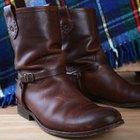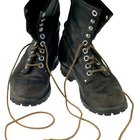
Protective overalls or coveralls are used as a uniform for some professions. They come in various styles, fabrics and thicknesses depending on the user’s needs. Some workers need liquid tight weaves to keep out moisture or dangerous chemicals, while others need protective fabrics that breathe to keep them cooler. Coveralls are made to protect the workers and make the job safer and more comfortable.
Protect Clothing
People working in wet or dirty environments wear protective overalls or coveralls to keep their clothing clean and dry. Fishermen, farmers, painters and oil rig workers wear overalls or coveralls on the job. They can step out of their overalls at the end of the day without a spot of paint, oil or dirt on their clothing.
Warmth
Protective overalls and coveralls add a layer of warmth for laborers who work outside in the elements. Waterproof coveralls can keep out rain, snow and cold winds. They can be found in a variety of fabric weights, with some lined to keep the user warm in arctic cold temperatures. Construction workers, public works or utility employees working in colder climates may look for warmth in protective overalls.
Body Protection
Coveralls cover the body from head to toe and are considered safety gear for certain professions. Some military branches issue coveralls as standard uniform. They protect the body from the elements, scratching branches in the field or splashing waves on the sea.
Some coveralls are made to be impermeable to protect the bodies of workers in contact with chemicals. People who work in laboratories or with hazardous wastes or pesticides wear protective coveralls for safety.
Fire resistant overalls are made with fabrics that can withstand high heat and flames. Firefighters, race car drivers and people who work with chemicals may look for overalls that are fire resistant to protect their bodies from high heat and flames encountered on the job.
Visibility
Bright orange overalls provide visibility to wearers, adding a layer of safety for those in dangerous conditions. Workers picking up trash along a highway and hunters may wear bright orange overalls so drivers and other hunters can see them easily. Fishermen could benefit from wearing orange overalls to increase their visibility if they should fall overboard.
Different Kinds
Protective overalls and coveralls come in a range of fabrics and weights. Some are disposable. Some are insulated. The right coverall for the job depends on what protection is needed. Whether the job is dirty, wet, cold or hot, there is an overall that will cover the worker.
Related Articles

What Are Croakies for Glasses?

What Kind of Clothing Should a Mechanic ...

How to Wear Steel Toe Shoes

What Is a Thermal Shirt?

What Clothes Do They Wear in Israel?

Types of Clothing Worn in Alaska

Three Warning Signs of Neglect

What Are the Dangers of Growing ...

How Does Thermal Underwear Work?

1950s Clothes for Children

Purpose of Moth Balls

How to Disinfect Sunglasses

Difference Between Body Spray & ...

What Looks Good With Men's Black Cargo ...

The History of Steel Toe Boots

The Benefits of Yellow Lenses in ...

How to Care for Frye Boots

How to Dry Leather Work Boots With a ...

Nomex Vs. Indura Cotton

Amber Vs. Grey Sunglasses
References
Writer Bio
Alice Drinkworth has been a writer and journalist since 1995. She has written for community newspapers, college magazines and Salon.com. Drinkworth earned a Bachelor of Arts in journalism from the University of Wisconsin and won a media award for her in-depth coverage of local politics. She is also a certified master gardener.
Photo Credits
Design Pics/Valueline/Getty Images